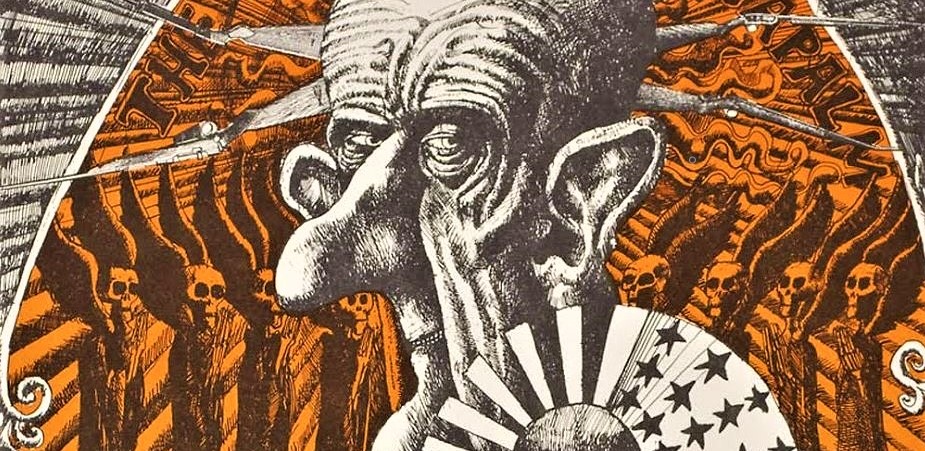The Madonna of the Napalm
Back on December 1, 2009 I wrote an illustrated article titled Hey, Hey, LBJ…, an essay concerning U.S. President Lyndon Baines Johnson as depicted in anti-Vietnam war posters from the 1960s. I self-published my treatise on the occasion of President Obama deploying 30,000 U.S. combat troops to Afghanistan.
While there are obvious differences between the Vietnam and Afghan wars, the parallels are striking. This article revisits the historic posters of the 60s that excoriated President Johnson for escalating the war in Southeast Asia, by examining a specific silkscreen print not included in Hey, Hey, LBJ…, Martin Sharp’s The Madonna of the Napalm.
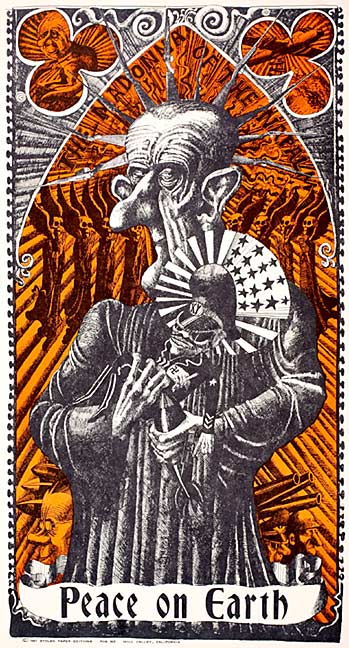
Sharp’s poster was created in 1967, and it is a good example of how the alternative culture of the 60s meshed with the antiwar activism of the period, however, an evaluation of the poster brings up unavoidable questions regarding the present day U.S. military intervention in Afghanistan.
Sharp’s Madonna of the Napalm is a biting condemnation, not just of military conflict, but of third world dictators, the compromised political leaders of Western democracies, religious piety distorted by fanaticism, and the overall decrepitude of “liberal” society rendered insane by imperialist war. We have not seen the likes of this poster since the late 1960s, but given the painful similarity between Obama’s Afghan catastrophe and Johnson’s Vietnam disaster, we ought to see such posters proliferate in the near future.
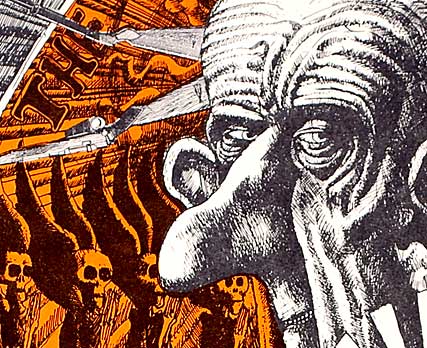
To start with, Sharp’s poster is a gem when it comes to psychedelia. His acerbic but fanciful caricatures were drawn with detailed though fluid pen lines, and when combined with vibrant fluorescent orange and black ink, an eye-popping visual was achieved. Moreover, Sharp’s semi-Gothic, neo-Art Nouveau style was the very epitome of psychedelic aesthetics.
One can only imagine the excitement his poster generated when viewed under the “black light” displays that were so popular during the sixties. But this was not simply another day-glo poster from the Aquarian Age, it was an angry political diatribe against the centers of power and fully intended to help incapacitate the war machine. Sharp’s Madonna of the Napalm represents a sub-genre rarely mentioned in modern-day coffee-table books dealing with psychedelic prints from the sixties, that of the political protest poster.

The central character in the poster is a depiction of President Johnson as an ancient Byzantine Madonna figure, but there is nothing sacred about this icon, who wears an imposing radiating nimbus made from rifles.
Floating in the heavens behind this demonic sham Madonna are skull-faced, black-winged angels of death. The unholy mother of war clutches a mortar shell in one claw, and a deformed puppet general in the other.
The general, with a glowing halo made from the U.S. flag, is none other than the U.S. backed Nguyen Cao Kỳ, who served as Prime Minister of South Vietnam from 1965 to 1967, and then served as the Vice President until he retired in 1971. Kỳ originally received military training from the French army, who founded the Vietnamese National Army (VNA) to help assist in their colonial control of “French Indochina.” Kỳ served the French well, but in 1954 when they finally departed Vietnam in military defeat, the VNA was reorganized into the American supplied and controlled Army of the Republic of Vietnam (ARVN).
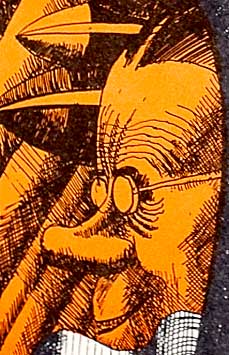
The background of Sharp’s Madonna of the Napalm presents some interesting character studies. At bottom left one can see Robert McNamara, the Secretary of Defense for Presidents John F. Kennedy and LBJ, and a primary architect of the U.S. war on Vietnam.
Starting out with the firm belief that the U.S. could win the war militarily, by May 1967 McNamara informed LBJ that the war was “becoming increasingly unpopular as it escalates – causing more American casualties, more fear of its growing into a wider war, more privation of the domestic sector, and more distress at the amount of suffering being visited on the noncombatants in Vietnam, South and North.” Six months later LBJ would remove McNamara from his post.
Contrast McNamara’s remarks to those made in May of 2010 by Obama’s Secretary of Defense Robert Gates, who said; “We’re not leaving Afghanistan prematurely, in fact, we’re not ever leaving at all.”
An anthropomorphized kangaroo figure holding a boomerang is depicted in the upper left corner of the poster; the caricature is of John Gorton, the pro-Vietnam war Prime Minister of Australia who governed from January 1968 to March 1971. Under Gorton’s administration around 8,000 Australian soldiers assisted the U.S. by fighting in Vietnam, but Australian public opinion turned against the war, hence the boomerang.
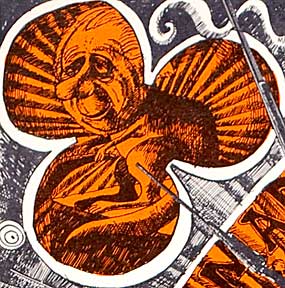
On May 1, 1970, over 200,000 people gathered in Melbourne, Australia for a mass protest dubbed the “Vietnam War Moratorium March.” Eventually some 50,000 Australian soldiers would be rotated into the war, around 3,000 would be wounded, and nearly 600 were killed. The last Australian soldiers would finally be withdrawn from Vietnam in 1972.
Since I first published Hey, Hey, LBJ…, on December 1, 2009, there have been numerous developments in Mr. Obama’s ever escalating war. In Dec. 2009 U.S. military fatalities in Afghanistan stood at 947, as of this writing 364 U.S. soldiers have been added to that list, for a total of 1,317 killed.
As our Nobel Peace Prize Laureate President intensifies his war, those casualty rates are rising. There are now around 100,000 U.S. soldiers in Afghanistan along with 52,000 allied NATO troops. The Afghan war is the longest in U.S. history, The ninth anniversary of the U.S. invasion of Afghanistan falls on October 7, 2010.


